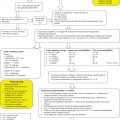Chapter 30
Obesity
Laura Stewart
Introduction
Obesity is the most common childhood nutritional disorder in the world and is widely acknowledged as being a global epidemic [1, 2]. In the UK the importance of implementing effective strategies for the prevention and treatment of childhood obesity has national significance with the publication of government policy documents [3, 4] as well as evidence based guidelines [5, 6]. The role of the specialist dietitian in the management of childhood obesity has now gained prominence. Dietitians may work with obese children and their families in primary or secondary care, utilising group or individual sessions [7, 8]. Background information, lifestyle advice and the use of behaviour change tools that a specialist paediatric dietitian will require to manage childhood obesity in any combination of these settings are discussed.
Definition
The definition of childhood overweight and obesity associates excess body fatness with the clinical relevance of such excess body fat. Body mass index (BMI) is generally recognised as the most appropriate proxy measure for body fat to define and diagnose childhood obesity and overweight [2, 5, 9]. BMI in childhood changes with age and differs between the sexes; therefore it must be plotted correctly on age and sex specific centile charts (UK 1990 data). UK BMI centile charts are available from Harlow Printing Ltd (see Useful addresses) and all dietitians working in the UK with obese children and adolescents should use these charts [10, 11].
There is a debate over the most appropriate centile cut-off points for defining childhood overweight and obesity; however, both the National Institute for Health and Care Excellence (NICE) and Scottish Intercollegiate Guideline Network (SIGN) clinical guidelines recommended ≥98th centile (UK 1990 data) for obesity and ≥91st centile (UK 1990 data) for overweight. For epidemiological studies ≥95th centile (UK 1990 data) defines obesity and ≥85th centile (UK 1990 data) defines overweight [5, 6].
Data on waist circumference centiles for British children [12] are available on the reverse side of the UK BMI centile charts. Currently, with no agreement on the relevant clinical cut-off points for the waist centile charts, they are not recommended for diagnosis of childhood obesity [2, 6, 9] although they have a use in monitoring progress.
Aetiology
Obesity is the accumulation of excess body fat associated with medical consequences (p. 800). The aetiology of all obesity is both complex and multifactorial [13]. It is well recognised that the development of childhood obesity is an interaction between the modern obesogenic environment and family lifestyle choices. Increases in the amount of energy dense foods eaten combined with large portion sizes, more time spent watching television, using computers and playing video games (screen time) with a simultaneous decrease in the amount of physical activity undertaken by children have all been mooted as causes of the current epidemic [2, 14, 15].
Genetics
The polygenetic theory of obesity suggests that the most common genetic cause will be found to involve a number of genes which could ‘predispose’ a person to gaining excess fat, which in turn would lead to obesity if or when that person is then exposed to an environment which encourages the necessary behaviours, i.e. a high energy diet and low levels of activity [16–18]. It has been suggested that by identifying common gene variants that predispose individuals to obesity subgroups of obese people could be targeted for particular interventions such as specific diets, behavioural approaches or drugs [19, 20]. The Human Obesity Gene Map is an interesting resource to look for information in this area [19]. Research into polygenetics and obesity is complex and it may be some years before any findings can be of use in day to day clinical practice [17].
Although described as rare, monogenetic causes of obesity in humans have been found [16, 21, 22] with much of the research being carried out by the Genetics of Obesity Study (GOOS) group. The GOOS project recruited children from across the world who have severe obesity (BMI >3.0 SD), a strong family history of obesity and from consanguineous families. The GOOS has identified seven monogenetic causes of obesity [18]. Most of these have involved mutations in leptin production, leptin receptors, propeptide pro-opiomelanocortin (POMC) and the melanocortin 4 receptor (MC4R) [16–18].
Mutations in MC4R are believed to be found in approximately 3%–5% of people with a BMI >40. Mutations in MC4R appear to result in a range of phenotypes ranging from those showing no obesity to individuals with severe obesity (particularly at an early age), hyperphagia, increased lean body mass, increased linear growth and hyperinsulinaemia [16, 21]. Deficiencies in the hormone leptin are reported to produce morbid obesity (usually from a young age), increased appetite, hyperphagia and hypogonadotropic hypogonadism. Injections of leptin in these individuals have been shown to reverse the hyperphagia and morbid obesity [16]. Individuals with POMC mutations are reported as having severe obesity (from an early age), hyperphagia, altered pigmentation, usually red hair and adrenal insufficiency [16, 22].
Inheritable disorders
A number of known inheritable disorders have obesity as a clinical feature of the syndrome. Lobstein et al. [2] noted around 30 such inherited disorders; most are associated with learning disabilities and dysmorphic features. The most common inherited disorders associated with childhood obesity seen in routine clinical practice are
- Down’s syndrome
- Prader–Willi syndrome
- Duchenne muscular dystrophy
- Fragile X
Endocrine causes
The endocrine glands produce hormones that are important in the regulation and maintenance of a stable body environment. In childhood they are important in ensuring normal growth and puberty. Dysfunction of these hormones can lead to hypothyroidism, growth hormone insufficiency, hypopituitarism, hypogonadotropic hypogonadism, hypogonadism, excessive corticosteroid administration, pseudohypoparathyroidism and craniopharyngioma, all of which are associated with rare causes of childhood obesity [23, 24].
Many of these endocrine disorders and the inheritable syndromes present with short stature as a clinical feature [23, 25]. There is strong agreement in clinical guidelines and practice that obese children who present with short stature for their age and weight should be referred to a paediatric endocrinologist for further investigation of possible underlying medical reasons for their obesity [2, 5, 6].
Consequences
There are a number of consequences of childhood obesity that are seen both in childhood and adolescence, and indeed later life. Clustering of cardiovascular risk factors has been reported in children and adolescents including high blood pressure; dyslipidaemia; abnormalities in left ventricular mass and/or function; abnormalities in endothelial function; hyperinsulinaemia and/or insulin resistance. There is evidence that these cardiovascular risk factors are seen in adults who were obese children or adolescents [26, 27]. Hyperinsulinaemia, the metabolic syndrome and type 2 diabetes are also seen in adolescents [28, 29]. Psychological problems, particularly in girls, have been reported in relation to low self-esteem and behavioural problems. There are also long term consequences of social and economic effects, particularly in women achieving a lower income [26, 27].
An important reason why tackling childhood and adolescent obesity is government policy is the evidence that obesity in childhood and adolescence tracks in to adulthood. Risk factors for persistence into adulthood include
- parental obesity (high risk if one parent is obese, higher if both are obese)
- level of obesity (increasing risk with increasing level of obesity)
- obesity in adolescence [26, 27]
Management
The role of the dietitian, either as a sole professional or as part of a multidisciplinary team, is to educate the child and family on the necessary lifestyle changes while facilitating behavioural change. A dietitian should be positive, non judgemental and empathetic while developing a rapport with the child and parents [30, 31].
For group sessions it is common practice to include some separate child and parents sessions. Practice shows that parents value the opportunity to discuss situations and solutions with other parents without the child being present. For dietitians working with individual children and their families consideration should also be given to seeing the parents alone, as information is often revealed by parents that would otherwise not be discussed in front of their child [7].
Good practice suggests that different age groups require different engagement:
- for preschool and lower primary school age children the intervention, including ownership and responsibility, engagement directly with the parent/carer
- for upper primary aged children engagement jointly with the child and parent/carer
- for teenagers engagement directly with the adolescent, with the parent in a supporting role
Assessment
At the first session weight and height should be measured and plotted on child growth centile charts. BMI should be calculated [weight (kg) ÷ height (m)2] and plotted at the correct age on the appropriate centile chart for sex (UK 1990 data). Although used regularly in research in clinical practice, arm anthropometry such as triceps skinfold measurement and mid upper arm circumference are rarely used. Taking the waist measurement can be difficult in obese children, but can be a useful tool in monitoring progress in weight management.
Lifestyle changes
Establishing current lifestyle
A ‘typical day’ scenario or a lifestyle diary is useful for establishing current lifestyle and is more child friendly for developing rapport [30, 31].
Behavioural change tools
Both NICE 43 and SIGN 115 guidelines concur that behavioural change tools in particular stimulus control, goal setting, self-monitoring, problem solving and use of rewards should be utilised in the management of childhood obesity [5, 6, 31].
Goal setting
Goal setting is used to help the child (and parents) to identify small and reasonable behavioural changes towards the long term target of positive lifestyle changes. Goal setting allows the child (and parents) to take responsibility and ownership for identifying the lifestyle changes they feel able to make and subsequently keep to these agreed goals [32, 33]. The dietitian should facilitate goal setting by ensuring that the goals are SMART: Specific, Measurable, Achievable, Recorded and Timed [7, 34]. Typically goals are written down to help with the continuing progress [35].
Rewards for reaching goals
Some programmes use ‘rewards’ for achieving the agreed lifestyle goal as these can be a positive reinforcement to both the setting and attainment of goals [33, 36, 37]. Rewards should be inexpensive, non food or screen time items such as a book, football or a family excursion. It should be remembered that praise can be a very powerful reward and should be utilised by the dietitian [35].
Self-monitoring of lifestyle
The recording of specific lifestyle elements by the child and/or parents is a key component of behavioural change tools which enhances motivation to change lifestyle by increasing self-awareness [33, 36, 38]. Monitoring the child’s food and drink intake, physical activity levels and screen time in a diary/journal helps raise awareness of current lifestyle, helps to identify potential goals for changes and then monitors progress towards their goals [35].
Problem solving
Problem solving is used to help the child and their parents to identify barriers and then to explore ways to overcome these barriers [33, 37]. A patient centred approach would recommend that the child and/or parent identify their own solutions to barriers and difficult situations [32, 35].
Stay updated, free articles. Join our Telegram channel

Full access? Get Clinical Tree






